Homemade Chicken Vegetable Soup: Your Ultimate Comfort & Wellness Bowl
There’s nothing quite like a hearty bowl of **homemade chicken vegetable soup** to bring warmth and comfort to any day. This classic recipe is a staple in kitchens worldwide, cherished for its rich flavors, nourishing qualities, and incredible versatility. Whether you’re battling a cold, seeking a wholesome meal, or simply craving a satisfying dish, this soup is a true culinary hug in a bowl. Packed with tender chicken, a vibrant medley of fresh vegetables, aromatic herbs, and a savory chicken broth, this isn’t just good soup—it’s truly exceptional. Let me guide you through crafting a perfect pot that’s not only delicious fresh but also freezes beautifully for future enjoyment.
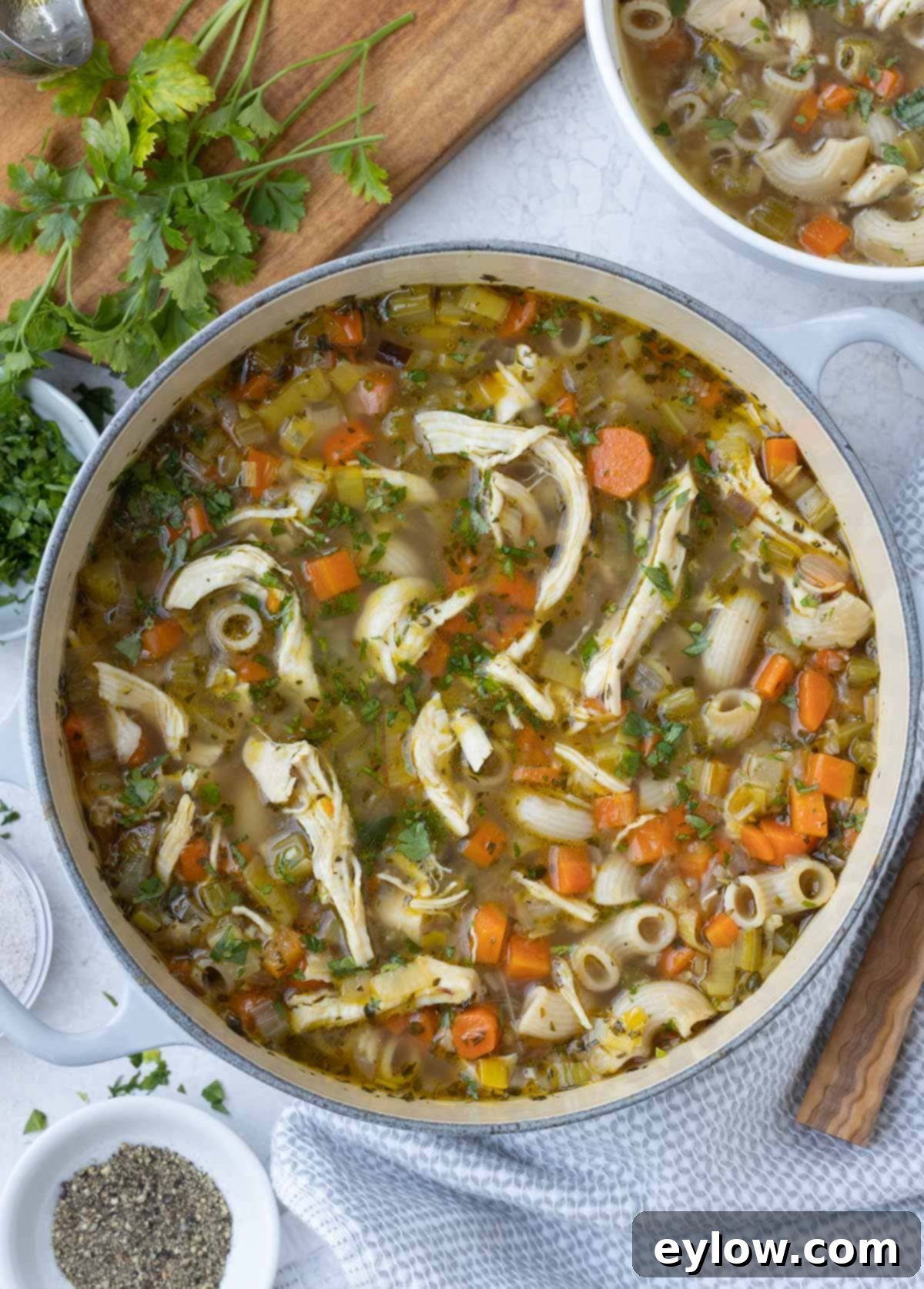
This recipe for wholesome chicken vegetable soup has been a treasured part of my cooking repertoire for decades, passed down and perfected since my mother first taught me the art of soup making. It’s a timeless, adaptable dish that you can customize to your heart’s content. Feel free to add your favorite pasta or rice for a heartier meal, or keep it light and simple, letting the fresh ingredients shine. The foundation of this soup is similar to a popular version I developed during my recipe creation work for The Daniel Plan Cookbook, emphasizing health, flavor, and ease of preparation. It’s truly a testament to how simple, good ingredients can create something extraordinary.
Making soup from scratch might seem daunting, but this recipe breaks down the process into easy, manageable steps. The reward is a deeply flavorful broth, succulent chicken, and tender-crisp vegetables that far surpass any store-bought alternative. This is more than just a meal; it’s a comforting ritual that nourishes both body and soul. Its ability to freeze well also makes it an ideal choice for meal prepping, ensuring you always have a healthy, delicious option on hand for busy weeknights.
[feast_advanced_jump_to]
Why You’ll Love This Homemade Chicken Vegetable Soup Recipe
This chicken vegetable soup stands out for several compelling reasons, making it a favorite in countless homes:
- Unbeatable Flavor & Health Benefits: Crafted with fresh ingredients, this soup delivers a robust, satisfying flavor profile that is both healthy and hearty. It’s packed with essential nutrients, making it perfect for boosting your immune system, especially during colder months or when you’re feeling under the weather.
- Flexible Chicken Options: While I highly recommend using raw, bone-in chicken breast for an unparalleled depth of flavor in the broth, this recipe is incredibly adaptable. You can easily substitute with boneless chicken or even use leftover shredded chicken from a baked chicken breast or a convenient rotisserie chicken, making it perfect for utilizing leftovers and saving time.
- Excellent for Meal Prep & Freezing: Not only does leftover chicken vegetable soup make a fantastic, quick lunch the next day, but it also freezes exceptionally well. Prepare a large batch and store it in individual portions for healthy, homemade meals whenever you need them. This makes weeknight cooking a breeze and reduces food waste.
- Simple & Straightforward: Despite its rich flavor, this recipe is surprisingly easy to follow, even for novice cooks. The steps are clear, and the ingredients are readily available.
- Customizable: Whether you prefer a lighter broth-based soup or a richer, heartier meal with pasta or rice, this recipe provides a fantastic base for endless customization to suit your taste and dietary needs.
If you’re looking for more delicious and healthy soup ideas, especially ones that make great use of leftover chicken, be sure to explore my Mexican Chicken Tortilla Soup recipe for a zesty kick or this robust Hearty Chicken Minestrone Soup.
Essential Ingredients for Your Perfect Chicken Vegetable Soup
Creating an outstanding chicken vegetable soup begins with selecting quality ingredients. Here’s a closer look at what you’ll need and why each component is vital for that signature delicious flavor:

- Chicken: The star of our soup! For the most flavorful broth and tender meat, I highly recommend using raw bone-in chicken. The bones slowly release collagen and marrow into the liquid as they simmer, creating a richer, more profound chicken flavor that elevates the entire soup. Alternatively, you can use pre-cooked, shredded chicken (from baked chicken breasts or a store-bought rotisserie chicken) to significantly reduce cooking time, adding it towards the end.
- Olive Oil: My preferred cooking oil for its health benefits and mild flavor. It’s perfect for sautéing the vegetables and building our flavor base. You can also opt for other healthy, neutral cooking oils like avocado oil or a high-quality, sustainable option such as cultured oil. Avoid using standard vegetable oils, as they often contain unhealthy fats and highly processed ingredients.
- Celery: A fundamental component of the classic mirepoix (onion, celery, carrot), which forms the aromatic foundation for many soups and stews. Celery adds a subtle, earthy note and contributes to the overall freshness. It’s also an often-overlooked nutritional powerhouse.
- Carrot: Provides natural sweetness, beautiful color, and additional nutrients to the soup. Along with onion and celery, it creates that essential aromatic base that gives the soup its comforting, familiar taste.
- Aromatics (Onion and Leek): This combination offers a complex, savory depth to the soup that a single aromatic might miss. Onion provides a sharp, foundational flavor, while leeks add a sweeter, more delicate oniony note. Using both creates a more nuanced and inviting aroma.
- Garlic: Indispensable for its pungent, savory flavor and its well-known health benefits. Always use fresh garlic, finely chopped, for the best results – dried garlic simply can’t compare in terms of flavor intensity and aroma.
- Fresh Herbs: Fresh thyme and parsley are game-changers, infusing the soup with bright, garden-fresh flavors and adding a lovely visual appeal. A bay leaf (dried is perfectly fine here) contributes a subtle, peppery undertone that deepens the broth. If you enjoy its unique anise-like flavor, a touch of fresh tarragon can also be a wonderful addition.
- Broth: The soul of the soup! Homemade chicken broth or Instant Pot chicken broth is always superior for its rich flavor and controlled ingredients. If using frozen, canned, or boxed broth, prioritize low-sodium options and carefully check the ingredient labels to avoid unhealthy additives, excessive sodium, or artificial flavorings.
- Salt and Black Pepper: Essential for seasoning. Adjust to your personal taste preference throughout the cooking process.
For precise measurements of all ingredients, including salt and black pepper, please refer to the detailed recipe card below.
Short on time? Consider this incredibly easy and flavorful Instant Pot Chicken Soup Recipe. It delivers delicious results in about 30 minutes, perfect for those busy weeknights when you still want a homemade meal.
Chef’s Tip for Broth Selection: The quality of your chicken broth (or chicken stock) can dramatically impact the final taste of your soup. Homemade broth is undeniably the healthiest and most flavorful choice, allowing you complete control over ingredients and sodium levels. If you own an Instant Pot or pressure cooker, my fast chicken broth recipe is a game-changer – it yields a rich, golden broth in a fraction of the time compared to traditional methods. For an even deeper, more nourishing broth, consider making a batch of long-cooking chicken bone broth. Both options are fantastic. Prepare large quantities and freeze them in convenient portions for quick use. If purchasing store-bought, head to the freezer section for higher-quality options, and always prioritize low-sodium brands after carefully reviewing the ingredient list.
Customizing Your Chicken Vegetable Soup: Endless Possibilities
One of the joys of cooking homemade soup is its adaptability. This chicken vegetable soup recipe serves as a perfect canvas for your culinary creativity. Don’t hesitate to experiment with these options to tailor the soup to your family’s preferences and what you have on hand:
- Chicken Choices:
- Boneless Skinless Chicken Thighs: If you prefer dark meat, boneless, skinless chicken thighs are an excellent alternative. They offer a rich, flavorful meat that stays incredibly moist. Simply trim any excess fat before adding them to the pot, then cook and shred as you would with breast meat.
- Boneless Skinless Chicken Breasts or Tenders: For a leaner option, use ¾ – 1 pound of boneless, skinless chicken breasts or tenders. While bone-in chicken imparts more flavor to the broth, boneless cuts cook faster.
- Pre-cooked Chicken: If using leftover shredded chicken (rotisserie, baked, or grilled), add it during the last 5-10 minutes of simmering, just long enough to heat through, to prevent it from becoming dry.
- Herb Alternatives:
- Dried Thyme: No fresh thyme? No problem! Use dried thyme or a dried Italian seasoning blend. As dried herbs are more concentrated, use about ⅓ to ½ the amount of fresh herbs specified (e.g., ¾ teaspoon dried thyme for 2 teaspoons fresh).
- Other Fresh Herbs: Experiment with other fresh herbs like rosemary (use sparingly as it’s strong), sage, or a hint of marjoram for different flavor profiles.
- Making it Heartier with Grains:
- Pasta: For a classic chicken noodle soup feel, add about ¾ cup of small pasta shapes like elbow macaroni, ditalini, or orzo directly to the soup pot during the last 10-15 minutes of cooking (or according to package directions). This will make the soup thicker and more filling. Choose regular wheat pasta or gluten-free pasta if needed.
- Rice: Both brown rice and white rice work wonderfully. To avoid a gummy texture, it’s best to cook rice separately until al dente, then add it to the soup at the very end, or use pre-cooked/frozen rice. This prevents the rice from absorbing too much broth and becoming mushy.
- Potatoes: For a hearty, starchy addition, chop gold or red potatoes into ½-inch cubes and add them to the soup along with the broth. Cook until tender, about 15-20 minutes. Gold potatoes are excellent as they hold their shape better than drier russet varieties, which are better suited for mashed potatoes.
- Boost More Veggies:
- Green Beans: Add a cup of chopped cooked green beans towards the end for extra color and nutrients.
- Spinach or Kale: Stir in a few handfuls of fresh baby spinach leaves or finely chopped kale during the last few minutes of cooking until wilted.
- Zucchini: Diced zucchini can be added during the last 10 minutes of simmering.
- Parsnips: Similar to carrots but with a unique sweet, earthy flavor, parsnips can be added with the other root vegetables.
- Fennel: Chopped fennel, with its subtle anise flavor, is one of my favorite additions for an unexpected gourmet touch.
- Flavor Enhancements:
- Umami Boost: For a deeper, savory umami flavor, add a small parmesan cheese rind to the soup while it simmers. Just remember to remove it before serving!
- Creamy Soup: For an indulgent, creamy chicken vegetable soup, use slightly less broth, and at the very end, stir in a splash of heavy cream, half-and-half, or full-fat coconut milk (for a dairy-free option). Heat gently until warmed through, but avoid boiling once dairy is added.
- Lemon Juice: A squeeze of fresh lemon juice right before serving can brighten all the flavors.
For another incredibly satisfying and robust soup, you might like this Turkey and Wild Mushroom Soup. It’s fantastic with leftover turkey, but equally delicious when made with leftover chicken.
Chef’s Tip: What to Avoid. To ensure your soup remains as healthy and delicious as possible, it’s crucial to steer clear of highly processed bouillon cubes or concentrated pastes, often marketed as “better than” products. Many of these contain undesirable ingredients like sugar, corn syrup solids, hydrolyzed soy protein, dried whey (dairy), ambiguous “flavoring,” food starch, disodium inosinate, and guanylate. Always take a moment to read the ingredient labels. If you see a long list of unpronounceable chemicals or excessive amounts of sodium and sugars, it’s best to skip it. Your homemade soup, rich in natural flavors from fresh ingredients and quality broth, simply doesn’t need these artificial enhancements. Stick to wholesome ingredients for the best flavor and nutritional value.
Step-by-Step Guide: How to Make Chicken Vegetable Soup
Follow these straightforward steps to create a wonderfully flavorful and comforting pot of homemade chicken vegetable soup. Remember, good soup takes a little patience, but the results are always worth it!

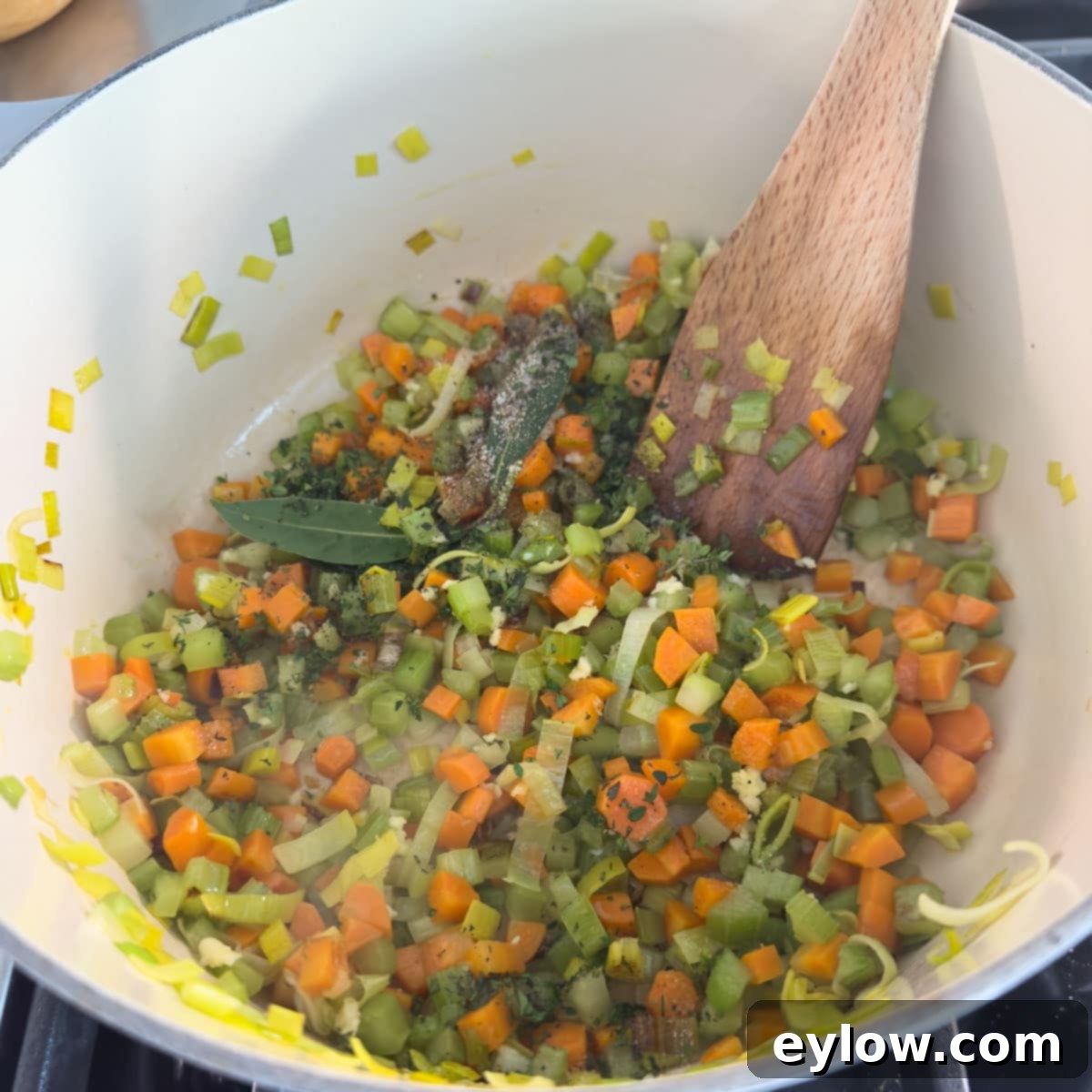
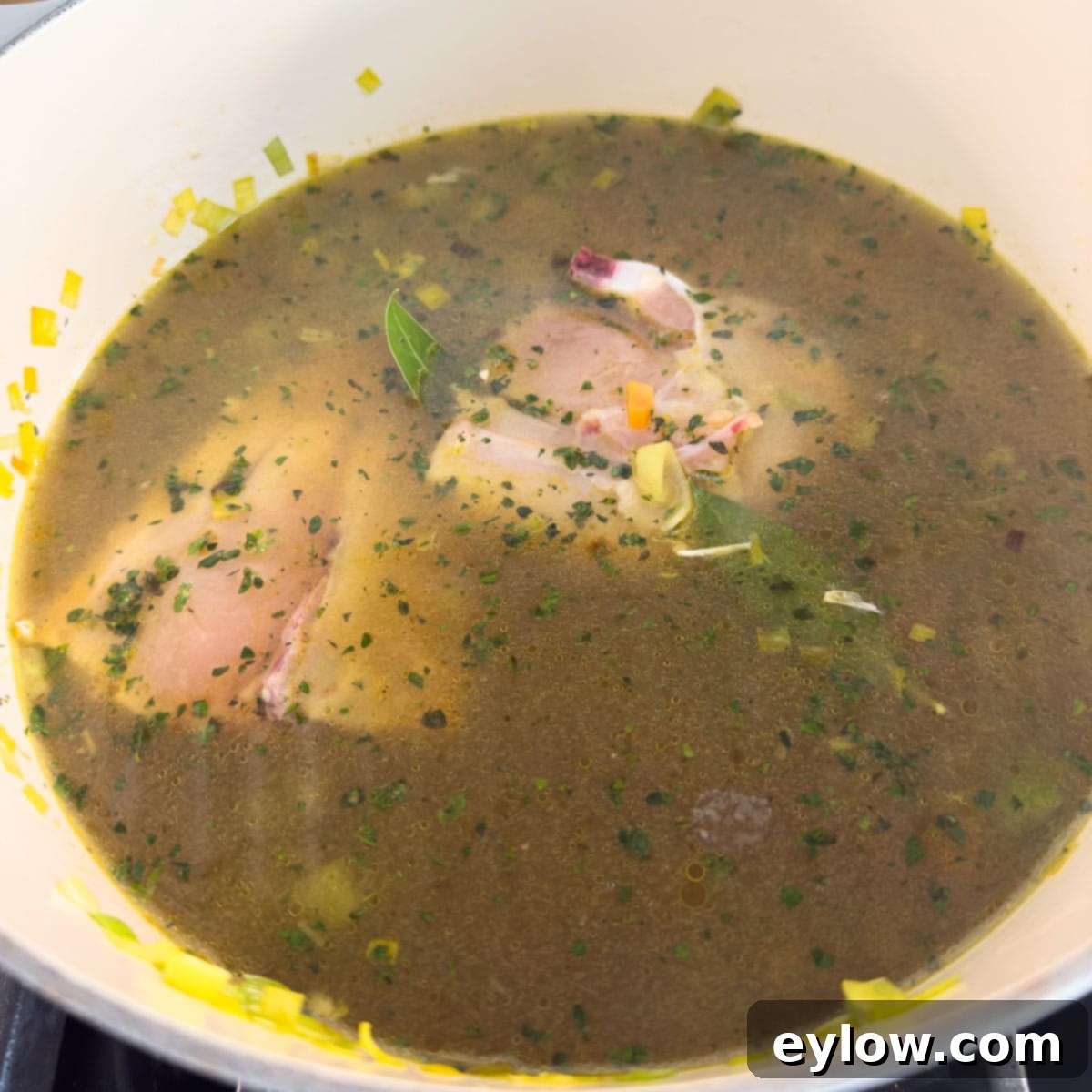
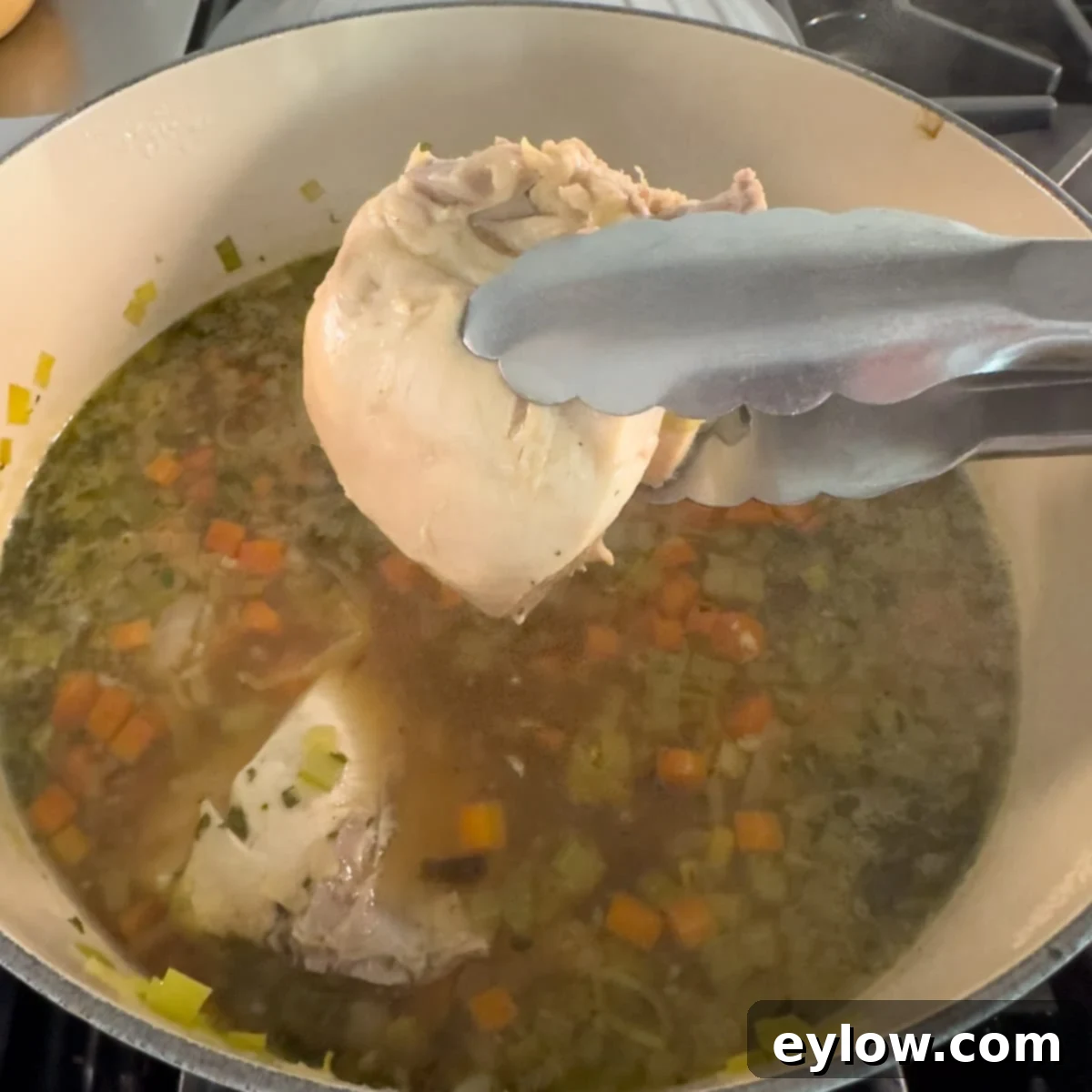
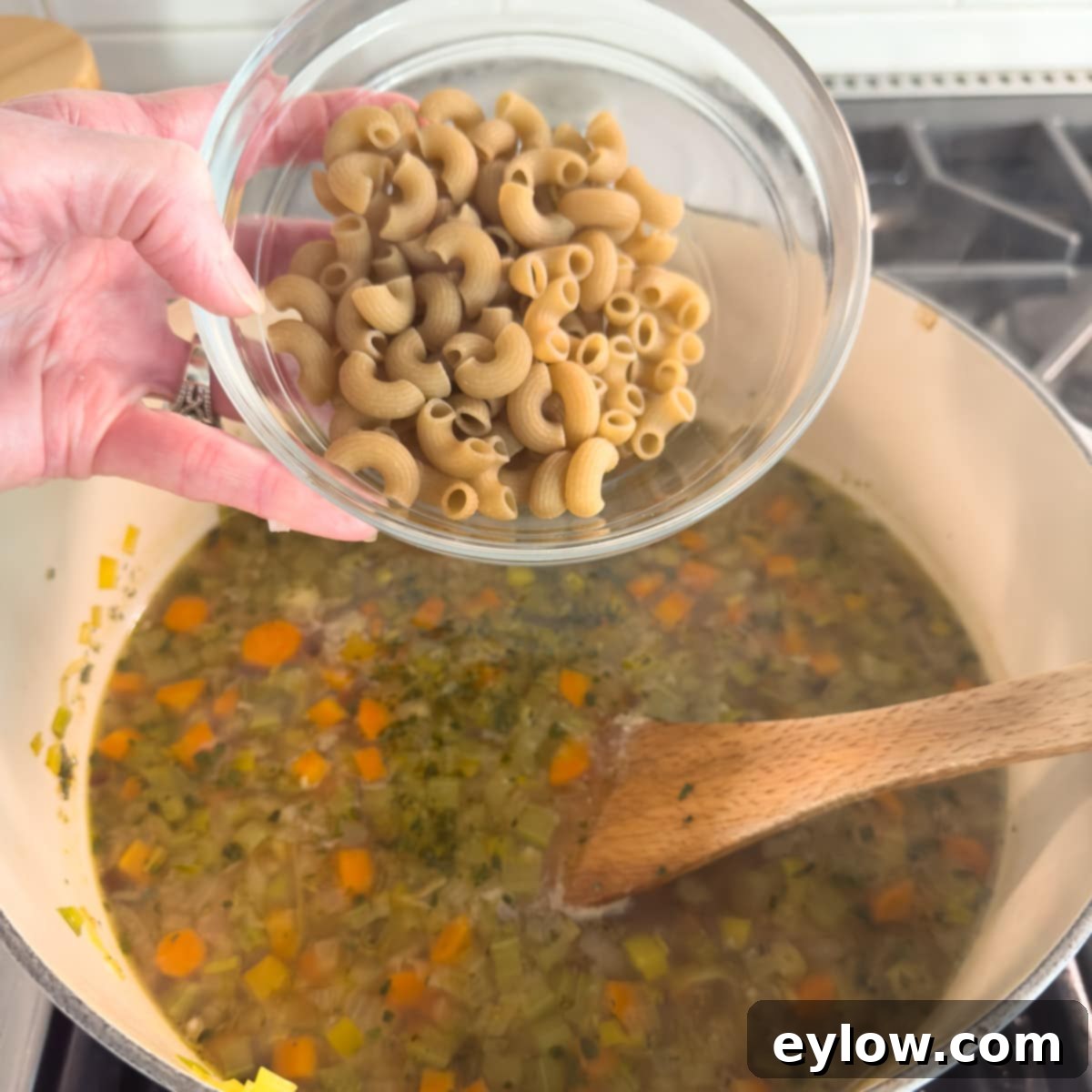

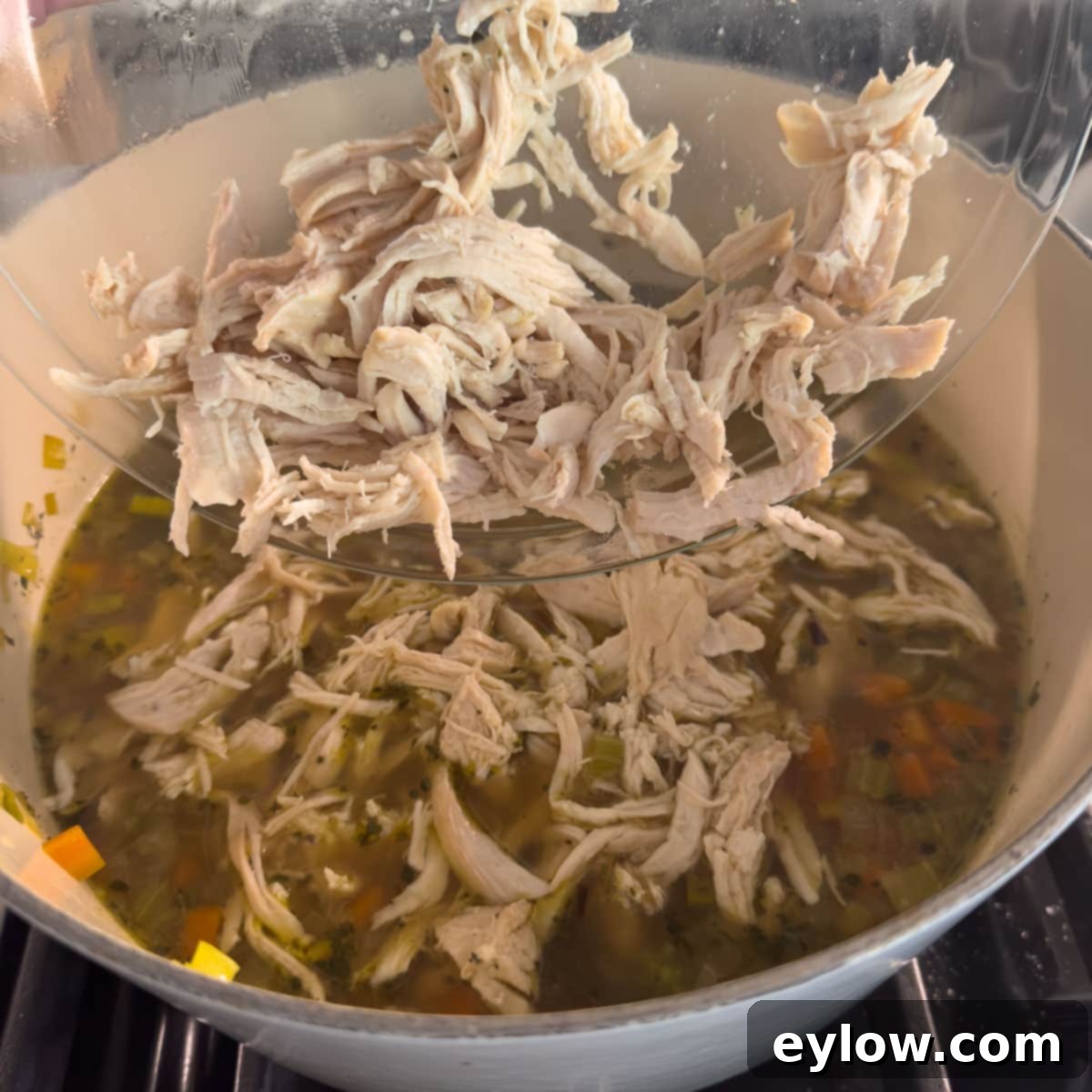
Serving Your Homemade Chicken Vegetable Soup
Your freshly prepared chicken vegetable soup is a complete meal in itself, but a few simple additions can elevate the dining experience. Serve it piping hot, allowing the comforting aromas to fill your kitchen.
- Classic Pairings: A crusty artisan roll, a slice of warm sourdough bread, or a piece of buttery garlic toast are perfect for soaking up every last drop of the savory broth.
- Light & Fresh Sides: If you desire a more substantial meal, complement your soup with a side leafy green salad tossed in a tangy homemade Italian dressing.
- Flavor Boosters: Offer fresh lemon wedges alongside the soup for guests to squeeze in a touch of bright, fresh lemon juice. This simple addition can remarkably lift and enhance all the flavors. A sprinkle of freshly grated Parmesan cheese or a dollop of pesto can also add another layer of flavor.
- Garnish Options: A final flourish of fresh chopped parsley or dill can add both visual appeal and a burst of fresh herb flavor.
Storage and Freezing Tips
One of the many benefits of this chicken vegetable soup is how well it stores, making it perfect for meal prepping:
- Refrigerator Storage: Leftover soup will keep beautifully in an airtight container in the refrigerator for 3-4 days. The flavors often deepen and meld even more overnight.
- Freezing for Later: For longer storage, this soup freezes exceptionally well. Allow the soup to cool completely before portioning it into freezer-safe containers. I recommend freezing in individual portions (12-16 ounces is ideal) in airtight containers. Label and date your containers, and the soup will remain fresh for 2-3 months. When ready to enjoy, simply thaw overnight in the refrigerator or gently reheat from frozen on the stovetop or in the microwave.
- Recommended Containers: For convenient freezing and storage, I highly recommend using durable silicone freezer containers or other high-quality airtight options specifically designed for freezing liquids. They work wonderfully and prevent freezer burn.
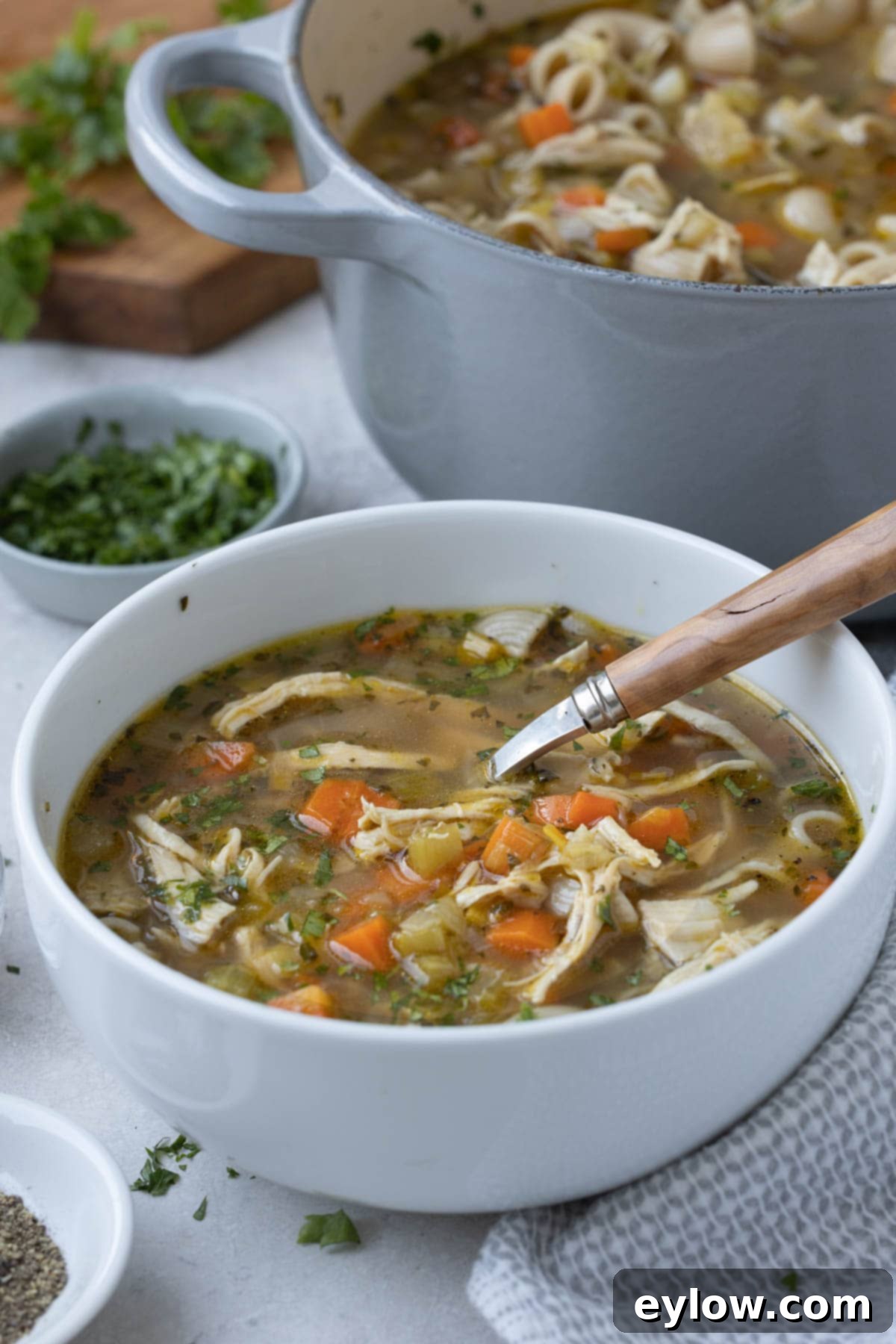
Frequently Asked Questions About Chicken Vegetable Soup
Here are answers to some common questions you might have about making this comforting chicken vegetable soup:
Absolutely! Making this chicken vegetable soup gluten-free or dairy-free is quite straightforward. For a gluten-free version, the primary consideration is your broth and any added pasta. If you’re using store-bought broth, ensure it is clearly labeled “gluten-free chicken broth,” as some brands may contain hidden gluten ingredients. When in doubt, or if you have a severe allergy, the safest and best option is to make your own homemade chicken broth, where you control every ingredient. If you plan to add pasta, simply opt for a certified gluten-free pasta (such as brown rice or corn-based varieties). For a dairy-free soup, the base recipe is naturally dairy-free. If you’re adapting it to be creamy, skip the heavy cream and instead use a plant-based milk or cream substitute, like full-fat coconut milk or a dairy-free culinary cream. Be aware that the texture and exact creaminess level might differ slightly from traditional dairy-based creams.
The best vegetables for a classic chicken vegetable soup always start with the foundational trio: onion, carrot, and celery. These form the aromatic base (mirepoix) that provides much of the soup’s depth and flavor. Beyond this classic combination, chopped leeks add a wonderful, delicate oniony sweetness. Parsnips, which resemble white carrots, are another excellent addition, offering a unique earthy sweetness. To boost the “green” factor and nutrient content, consider adding chopped green beans, fresh baby spinach leaves, or finely chopped kale towards the very end of the cooking process, just until they are wilted. For a more adventurous and flavorful twist, finely chopped fennel can introduce a subtle, fresh anise note that I personally adore. You can also experiment with diced bell peppers, corn, or peas for added color and texture.
Absolutely! Adding pasta, rice, or even potatoes is an excellent way to make your chicken soup even more hearty and filling, transforming it into a complete meal. For pasta, small shapes like elbow macaroni, ditalini, or orzo work best. Add them directly to the simmering soup after removing the chicken, and cook until they are tender according to package directions. If using rice, whether brown or white, it’s generally best to cook it separately until al dente and then stir it into the soup at the very end. This prevents the rice from becoming overly mushy or absorbing too much of your precious broth. Another fantastic option is adding cubed potatoes; I highly recommend using waxy varieties like gold or red potatoes, cut into ½-inch pieces. Add them with the broth and simmer until tender. These varieties hold their shape well in soup, unlike drier russet potatoes which tend to break down and are better reserved for mashed potatoes.
To transform this recipe into a delicious vegetarian vegetable soup, simply omit the chicken entirely and replace the chicken broth with a high-quality vegetable broth. You can also add more plant-based protein sources like canned, rinsed, and drained white beans (cannellini, great northern), chickpeas, or even a handful of lentils (cooked separately and added at the end) to maintain a hearty texture. Consider boosting the umami with a splash of soy sauce or a vegetarian mushroom broth if desired.
Explore More Delicious Chicken Soup Recipes
If you’ve fallen in love with the comforting taste of homemade soup, then you’re in luck! I have a whole collection of warming and satisfying recipes waiting for you. Head over to my Soups, Stews, and Chilies page for a diverse array of options. Homemade soups are a welcome addition to the table almost any time of the year, offering nourishing comfort and incredible flavor. From light broths to hearty stews, there’s always something new to discover.
- Mexican Chicken Tortilla Soup Recipe
- Easy Instant Pot Chicken Rice Soup Recipe
- Mexican Chicken Tomatillo Soup
- Easy Instant Pot Chicken Broth
⭐️ Did You Make This Recipe? Your Feedback Matters!
If you’ve had the pleasure of making this homemade chicken vegetable soup, I would be absolutely thrilled to hear from you! Please take a moment to leave your comment below. Your feedback is invaluable, and I truly enjoy connecting with fellow food lovers. If you loved this recipe and found it comforting and delicious, kindly consider giving it a 5-star rating! Your ratings and reviews are incredibly helpful to other readers looking for wholesome and satisfying recipes.
📖 Recipe
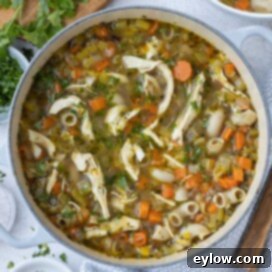
Homemade Chicken Vegetable Soup Recipe
Sally Cameron
Pin Recipe
Equipment
-
Large soup pot like a Dutch oven
Ingredients
- 2 tablespoons olive oil
- 1 ¼ cups chopped onion (half a large onion)
- 1 ¼ cups chopped celery (2-3 ribs)
- 1 ¼ cups chopped carrots (2-3 carrots)
- 1 cup chopped leek (pale green parts only, 1 medium leek)
- 2-3 cloves fresh garlic (chopped fine)
- 2 teaspoons minced fresh thyme (or ¾ teaspoon dried thyme)
- 1 bay leaf
- ¼ teaspoon Kosher or sea salt (or more, to your taste preference)
- ¼ teaspoon freshly ground black pepper
- 6 cups chicken broth (low sodium or homemade, approximately 48 ounces)
- 1 large bone-in chicken breast (approximately 1 pound)
- 1 tablespoon fresh parsley (finely chopped, for garnish and flavor)
Optional Add-ins
- ¾ cup elbow macaroni pasta (gluten-free or regular wheat, optional)
- 1 cup small-cubed gold potatoes (optional, add with broth)
- 1 can (15-ounce) white beans (e.g., cannellini, great northern, rinsed and drained, optional)
Instructions
-
In a large, heavy pot or Dutch oven, heat the olive oil over medium heat until shimmering. Add the chopped onion, celery, carrots, and leek to the pot. Sauté, stirring occasionally, for about 10-12 minutes, or until the vegetables have softened and become translucent. Monitor the heat carefully to ensure the vegetables cook gently without burning or browning too quickly. If needed, reduce the heat. Stir in the minced garlic and cook for an additional 30-60 seconds until aromatic. Be careful not to overcook the garlic, as it can turn bitter. Finally, add the fresh or dried thyme, bay leaf, Kosher or sea salt, and freshly ground black pepper, stirring to thoroughly combine with the softened vegetables.
-
Prepare the chicken breast by removing its skin and any excess fat. For more even cooking, you can cut the bone-in chicken breast crosswise through the bone into two pieces using a chef’s knife. Carefully add the prepared chicken breast pieces to the pot, submerging them in the sautéed vegetables. Pour in the 6 cups of chicken broth. Increase the heat to bring the soup to a gentle boil, then immediately reduce the heat to low. Cover the pot with a lid and let the soup simmer for approximately 15-20 minutes, or until the chicken is fully cooked through and reaches an internal temperature of 165°F (74°C).
-
Once the chicken is cooked, use tongs to carefully remove it from the pot and transfer it to a cutting board or shallow dish to cool slightly. While the chicken cools, if you are adding pasta (like elbow macaroni) or cubed potatoes to the soup, increase the heat slightly and add them to the pot now. Simmer uncovered until the pasta or potatoes are tender to your desired consistency; this typically takes around 8-12 minutes for pasta, depending on the type.
When the chicken is cool enough to handle, shred the meat from the bone using two forks. Discard the bone and any remaining skin. Once the pasta or potatoes are cooked, return the shredded chicken meat to the pot. Remove and discard the bay leaf. Stir in the finely chopped fresh parsley. Taste the soup and adjust seasonings with additional salt and black pepper as needed. Ladle the hot chicken vegetable soup into warm bowls and serve immediately, enjoying this comforting homemade meal.
Notes
- For a heartier meal, stir in pasta such as elbow macaroni (use gluten-free or regular wheat).
- Alternatively, add cooked rice (white or brown) at the very end to prevent it from getting mushy.
- Include small-cubed gold potatoes with the broth and cook until tender for a comforting, starchy addition.
- Boost protein and fiber by adding a can of rinsed and drained white beans, such as cannellini, great northern, or small white beans.
- You can also skip all these additions for a lighter, simple chicken vegetable soup.
Important Dietary Notes:
This soup recipe is generally histamine-friendly, but always review the ingredients carefully to identify any potential triggers specific to your sensitivities. For the lowest histamine option, I recommend using my Instant Pot chicken broth recipe, as it is typically lower in histamine than a long-cooking chicken bone broth and a safer bet than many store-bought varieties.
For a Low Sodium Version: It’s best to use homemade broth, as you control the salt content completely (no added salt in the broth itself). In the recipe, either omit salt or use it very sparingly. To compensate for reduced salt, a generous squeeze of fresh lemon juice at the end can provide a wonderful lift of flavor. Remember that even many “low sodium” chicken broth brands can still contain significant amounts of sodium.
